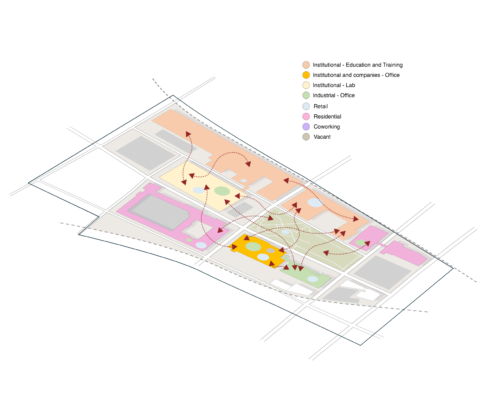 https://www.giid.org/wp-content/uploads/2024/03/Centrality-of-Land-Body-image-White-BG.png
1368
1690
Federico Jorge
https://www.giid.org/wp-content/uploads/2019/01/Global-Institute-on-Innovation-Districts-logo-color.png
Federico Jorge2024-04-09 08:53:162024-04-10 10:37:17Innovation Districts and the Centrality of Land
https://www.giid.org/wp-content/uploads/2024/03/Centrality-of-Land-Body-image-White-BG.png
1368
1690
Federico Jorge
https://www.giid.org/wp-content/uploads/2019/01/Global-Institute-on-Innovation-Districts-logo-color.png
Federico Jorge2024-04-09 08:53:162024-04-10 10:37:17Innovation Districts and the Centrality of LandThe Rise of Innovation Districts
For the past 50 years, the landscape of innovation has been dominated by places like Silicon Valley—suburban corridors of spatially isolated corporate campuses, accessible only by car, with little emphasis on the quality of life or on integrating work, housing and recreation.
A new complementary urban model is now emerging, giving rise to what we and others are calling “innovation districts.” These districts, by our definition, are geographic areas where leading-edge anchor institutions and companies cluster and connect with start-ups, business incubators and accelerators.1 They are also physically compact, transit-accessible, and technically-wired and offer mixed-use housing, office, and retail.
Innovation districts are the manifestation of mega-trends altering the location preferences of people and firms and, in the process, re-conceiving the very link between economy shaping, place making and social networking. Our most creative institutions, firms and workers crave proximity so that ideas and knowledge can be transferred more quickly and seamlessly. Our “open innovation” economy rewards collaboration, transforming how buildings and entire districts are designed and spatially arrayed. Our diverse population demands more and better choices of where to live, work and play, fueling demand for more walkable neighborhoods where housing, jobs and amenities intermix.
Led by an eclectic group of institutions and leaders, innovation districts are emerging in dozens of cities and metropolitan areas in the United States and abroad and already reflect distinctive typologies and levels of formal planning. Globally, Barcelona, Berlin, London, Medellin, Montreal, Seoul, Stockholm and Toronto contain examples of evolving districts. In the United States, districts are emerging near anchor institutions in the downtowns and midtowns of cities like Atlanta, Baltimore, Buffalo, Cambridge, Cleveland, Detroit, Houston, Philadelphia, Pittsburgh, St. Louis and San Diego. They are developing in Boston, Brooklyn, Chicago, Portland, Providence, San Francisco and Seattle where underutilized areas (particularly older industrial areas) are being re-imagined and remade. Still others are taking shape in the transformation of traditional exurban science parks like Research Triangle Park in Raleigh-Durham, which are scrambling to keep pace with the preference of their workers and firms for more urbanized, vibrant environments.
Innovation districts have the unique potential to spur productive, inclusive and sustainable economic development. At a time of sluggish growth, they provide a strong foundation for the creation and expansion of firms and jobs by helping companies, entrepreneurs, universities, researchers and investors—across sectors and disciplines—co-invent and co-produce new discoveries for the market. At a time of rising social inequality, they offer the prospect of expanding employment and educational opportunities for disadvantaged populations given that many districts are close to low- and moderate-income neighborhoods. And, at a time of inefficient land use, extensive sprawl and continued environmental degradation, they present the potential for denser residential and employment patterns, the leveraging of mass transit, and the repopulation of urban cores.
Today, innovation is taking place where people come together, not in isolated spaces.
The rise of innovation districts aligns with the disruptive dynamics of our era and represents a clear path forward for cities and metropolitan areas. Local decision makers—elected officials and heads of large and small companies, local universities, philanthropies, community colleges, neighborhood councils and business chambers—would be wise to unleash them. Global companies and financial institutions would be smart to embrace them. States and federal government should support and accelerate them. The result: a step toward building a stronger, more sustainable and more inclusive economy in the early decades of this young century.


